Sonicwall 054 Ethernet Firewall/VPN/Router 10/100MB with WLAN User Manual
Sonicwall, Inc. Ethernet Firewall/VPN/Router 10/100MB with WLAN
usermanual

SonicWALL TZ 150 Wireless Getting Started Guide Page 1
SonicWALL TZ 150 Wireless Security
Appliance Getting Started Guide
The SonicWALL® TZ 150 Wireless is a total security platform for both
your wired and wireless network, delivering true layered security by
integrating gateway anti-virus, intrusion prevention and content
filtering capabilities for small networks in an easy-to-use, low cost
platform.
This Getting Started Guide provides instructions for basic installation
and configuration of the SonicWALL TZ 150 Wireless. After you
complete this guide, up to 10 computers on your Local Area Network
(LAN) will have secure Internet access.
Note: For complete documentation, refer to the SonicOS Standard
Administrator’s Guide on the SonicWALL Resource CD or at:
<http://www.sonicwall.com/us/support.html>.
Before You Begin
Check Package Contents
• One SonicWALL TZ 150 Wireless security appliance
• One SonicWALL TZ 150 Wireless Getting Started Guide
• One SonicOS Standard 3.1 Release Notes
• One Ethernet cable
• One 12V, 1.66A power supply
• One SonicWALL Resource CD, which contains product
documentation and software utilities.
Any Items Missing?
If any items are missing from your package, contact:
SonicWALL Support
Web: <http://www.sonicwall.com/support/>
E-mail: customer_service@sonicwall.com

Page 2
SonicWALLTZ 150 Wireless Configuration
This Getting Started Guide covers the following procedures.
Procedures 1 through 6 are required for initial configuration of your
SonicWALL TZ 150 Wireless security appliance.
Collect Required Information page 3
Applying Power to the SonicWALL TZ 150 Wireless page 4
Connecting the SonicWALL TZ 150 Wireless page 5
Accessing the Management Interface page 7
Using the SonicWALL Setup Wizard page 9
Registering Your SonicWALL TZ 150 Wireless page 20
Activating SonicWALL Security Services page 25
Connecting Wireless Clients to the
SonicWALL TZ 150 Wireless page 29
Connecting Computers to Your SonicWALL TZ 150 Wireless
page 33
Wall Mounting the SonicWALL TZ 150 Wireless page 36
What You Need to Begin
• A computer to use as a management station for initial
configuration of the SonicWALL TZ 150 Wireless
• An Internet connection
• A Web browser for accessing the SonicWALL TZ 150 Wireless’s
Web-based management interface. The Web browser must
support Java and HTTP uploads. Internet Explorer 5.0 or higher
or Netscape Navigator 4.7 or higher are recommended.
1
2
3
4
5
6
7
8
9
10

SonicWALL TZ 150 Wireless Getting Started Guide Page 3
Collect Required Information
Internet Service Provider (ISP) Information
Collect the following information about your Internet service:
Note: If you are not using one of the network configurations above,
refer to the SonicOS Standard Administrator’s Guide available on the
SonicWALL Resource CD and on the Web at:
<http://www.sonicwall.com/us/support.html>.
If you connect
via
You
probably
use Please record
Cable modem,
DSL with a router
DHCP You do not need to provide any Internet
connection information.
Home DSL PPPoE User Name:
Password:
Note: Your ISP may require your user
name in the format: name@ISP.com
T1,
Static broadband,
Cable or DSL
with a static IP
Static IP IP Address:
Subnet Mask:
Default Gateway
(Router Address):
Primary DNS:
S e c o n d a r y D N S ( o pt i o n al):
Dial in to a server PPTP Server Address:
User Name:
Password:
1
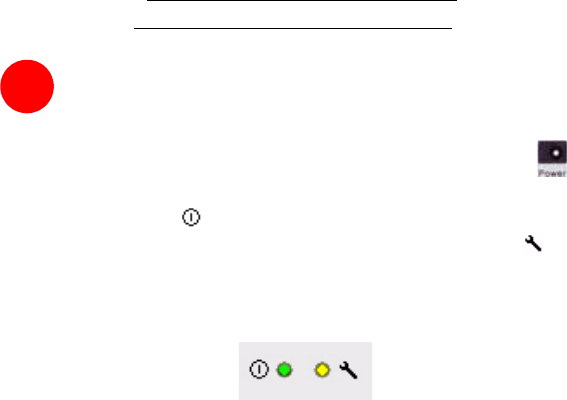
Page 4
Other Information
SonicWALL Management Interface
To access the SonicWALL TZ 150 Wireless Web-based
management interface. These are the default settings, which you
can change:
User Name: admin
Password: password
Applying Power to the
SonicWALLTZ 150 Wireless
1. Plug the power supply into back of the security appliance and
into an appropriate power outlet.
The Power LED on the front panel lights up green when you
plug in the SonicWALL TZ 150 Wireless. The Test LED may
light up and may blink while the appliance performs a series of
diagnostic tests. When the Test light is no longer lit, the security
appliance is ready for configuration.
If the Test LED remains lit after the SonicWALL TZ 150 Wireless
has booted, Restart the security appliance.
For more trouble shooting information, refer to the SonicOS
Standard Administrator’s Guide available on the SonicWALL
Resource CD and on the Web at:
<http://www.sonicwall.com/us/support.html>
2
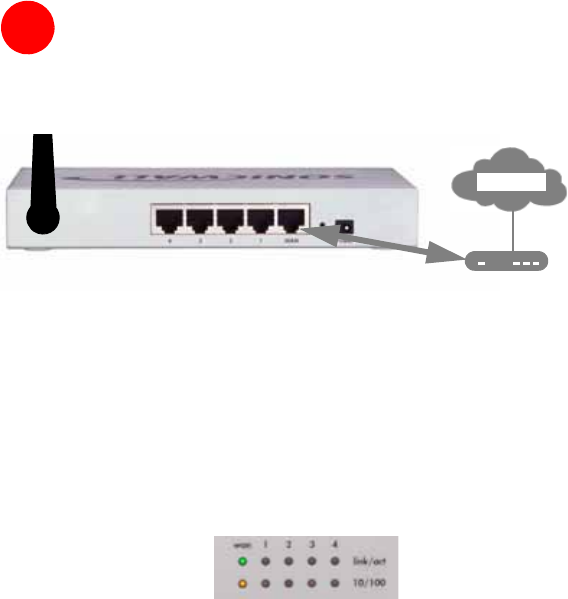
SonicWALL TZ 150 Wireless Getting Started Guide Page 5
Connecting the
SonicWALLTZ 150 Wireless
Connecting the Ethernet Cables
Connect the WAN Cable
1. Connect one end of an Ethernet cable to your Internet
connection, such as a DSL modem or cable modem.
This cable may already be connected between your computer
and your modem. If so, disconnect it from your computer, and
leave it connected to the Internet.
2. Connect the other end of the cable to the WAN port on the back
of your SonicWALL TZ 150 Wireless.
The WAN LEDs on the front panel light up indicating an active
connection.
3
WAN Modem or Router
Internet
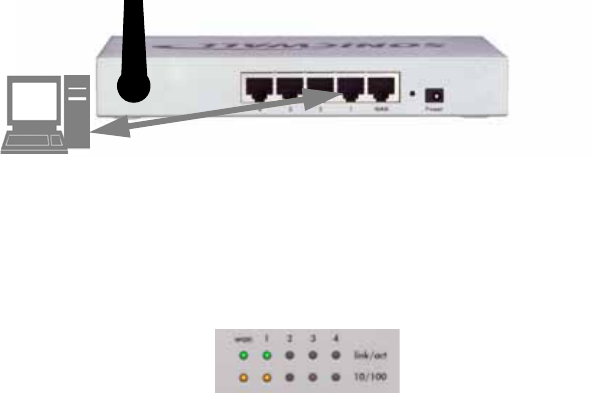
Page 6
Connect the LAN Cable
1. Connect one end of another Ethernet cable to the computer you
are going to use to manage the SonicWALL TZ 150 Wireless.
2. Connect the other end of the cable to port # 1 on the back of your
SonicWALL TZ 150 Wireless.
The port # 1 LEDs on the front panel light up indicating an active
connection.
Management
Station
port 1
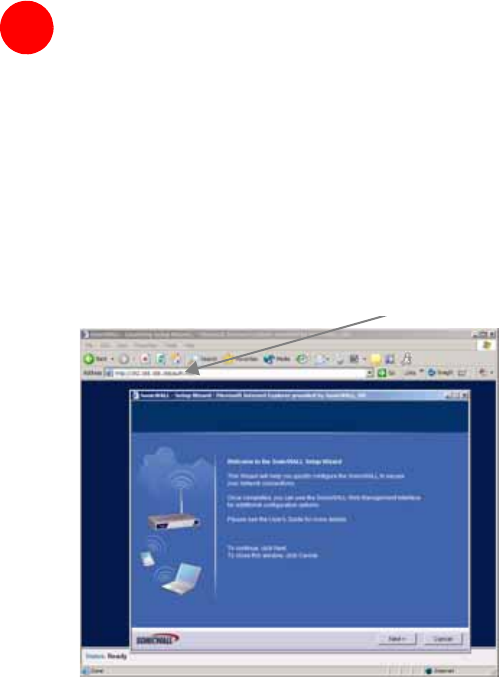
SonicWALL TZ 150 Wireless Getting Started Guide Page 7
Accessing the Management Interface
To access the Web-based management interface of the
SonicWALL TZ 150 Wireless:
1. On the computer you have connected to port # 1, Start your Web
browser.
Alert: Turn off pop-up blocking software before accessing the
SonicWALL management interface.
Your Web browser must support Java and HTTP uploads.
Internet Explorer 5.0 or higher or Netscape Navigator 4.7 or
higher are recommended.
2. Enter http://192.168.168.168 in the Location or Address field.
3. The SonicWALL Setup Wizard launches and guides you
through the configuration and setup of your
SonicWALL TZ 150 Wireless.
4
Page 8
If the SonicWALL Setup Wizard Does Not Appear
If you cannot connect to the SonicWALL TZ 150 Wireless or the
Setup Wizard does not display, verify the following
configurations:
• Did you correctly enter the SonicWALL TZ 150 Wireless
management IP address in your Web browser?
• Is your computer running pop-up blocking software?
• Are the Local Area Connection settings on your computer set
to obtain an IP address dynamically (DHCP)? see Procedure
7, “Connecting Computers to Your
SonicWALL TZ 150 Wireless” on page 33 for instructions on
changing your Local Area Connection settings.
• Do you have the Ethernet cable connected to your computer
and to port 1 on your SonicWALL TZ 150 Wireless?
• Some browsers may not launch the Setup Wizard
automatically. In this case, log into
SonicWALL TZ 150 Wireless using “Admin” as the user
name and “password” as the password. After you log in,
click the Wizards button on the
System > Status page. Select Setup to begin configuring
your SonicWALL TZ 150 Wireless.
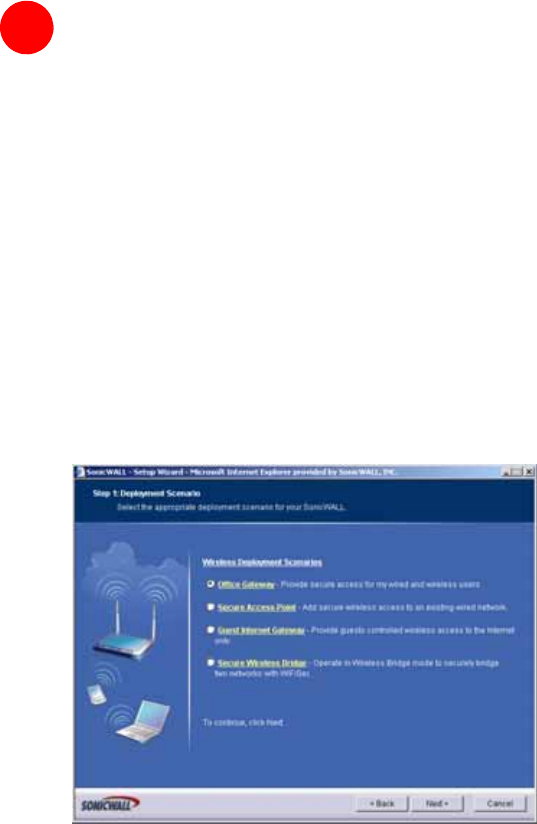
SonicWALL TZ 150 Wireless Getting Started Guide Page 9
Using the SonicWALL Setup Wizard
The SonicWALL Setup Wizard provides user-guided instructions for
configuring your SonicWALL TZ 150 Wireless.
Note: Make sure you have any required ISP information to complete
the configuration before using the Setup Wizard. See the list of
required information in Procedure 1, “Collect Required Information”
on page 3.
Tip: If you do not know what type of Internet connection you have,
contact your ISP. In addition, the SonicWALL Setup Wizard will
attempt to detect your connection settings. You will see what is
automatically selected in Setup Wizard page 4, WAN Network Mode
Welcome - Click Next to begin.
1. Deployment Scenario - select the wireless deployment scenario
that best matches your deployment requirements. Clicking on the
deployment scenario link displays a diagram of the deployment to
show how the scenario is best used.
5
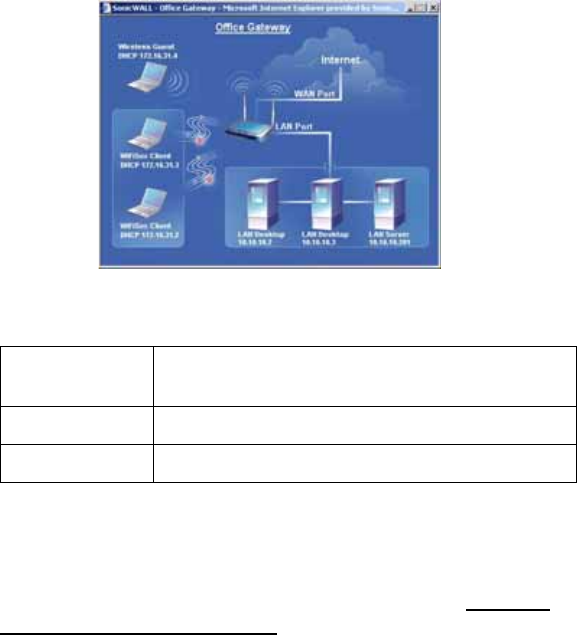
Page 10
Select Office Gateway, which is a commonly used wireless
deployment for LAN and WLAN to Internet connectivity.
2. Change Password - Change the administrative password. This
is the password for the admin account.
!
Note: Keep your new password in a safe place. If you lose your
password, you will have to reset the SonicWALL TZ 150 Wireless
to factory settings, losing your configuration. For instructions on
resetting your SonicWALL TZ 150 Wireless, See the SonicOS
Standard Administrator’s Guide available on the SonicWALL
Resource CD and on the Web at:
<http://www.sonicwall.com/us/support.html>
Click Next.
Old Password Should be populated with the default password,
password.
New Password Enter your new password.
Confirm Re-enter your new password.

SonicWALL TZ 150 Wireless Getting Started Guide Page 11
3. Change Time Zone - Change the Time Zone setting to your
local time zone.
Click Next.
!
Note: It is important that you set the time zone correctly before
you register your SonicWALL TZ 150 Wireless.
4. WAN Network Mode - The Setup Wizard automatically detects
most networking modes. If it does not detect the networking
mode, you may have a Static IP Address. See Procedure 1,
“Collect Required Information” on page 3.
Confirm the selection or select the correct type of network
connection for your network.
Click on the yellow link for a networking type to see a definition.
Click Next.
Time Zone Select the time zone for your location from the list.
Automatically
adjust clock
for daylight
saving time
Check this if you live in an area that observes Day-
light Savings Time.
Static IP Select Static IP if you want to give the
SonicWALL TZ 150 Wireless a specific, unchanging
IP address.
DHCP Select DHCP if your ISP assigns your computer a
dynamic IP Address. DHCP is commonly used with
cable modems.
PPPoE Select PPPoE if your ISP requires a username and
password to establish a connection and assign a
dynamic address. PPPoE is commonly used with
DSL modems.
PPTP Select PPTP if you dial into a specific server and log
into a VPN to establish a connection. With PPTP,
you can have either a static or dynamic IP Address.

Page 12
5. WAN Network Mode - The second WAN network mode page
configures your WAN settings for the selection you made in the
previous page.
WAN Network Mode: NAT Enabled (Static IP)
Click Next.
WAN Network Mode: NAT with DHCP Client
You do not need to enter any WAN networking settings. The
network settings are provisioned automatically from a DHCP
server.
Click Next.
SonicWALL
WAN IP
Address
Enter a single, static IP address. This must be in
the correct address range for your ISP.
WAN Sub-
net Mask Enter the subnet mask for your network, for
example, 255.255.255.0.
Gateway
(Router)
Address
Enter the IP address of your internet gateway.
DNS Server
Address Enter the IP address of the DNS server for your
network.
DNS Server
Address #2
(optional)
You can enter a secondary, back-up DNS server
to use if the first one fails.

SonicWALL TZ 150 Wireless Getting Started Guide Page 13
WAN Network Mode - NAT with PPPoE Client
Click Next.
Obtain an
IP Address
Automatically
Select this if your ISP assigns you a dynamic
IP address.
Use the
following
IP Address
Select this if your ISP has assigned you a
static IP address, and enter the address.
PPPoE User
Name Enter the user name for your Internet account.
The username usually includes “@” and the
domain name, for example, joe.user@ispgate-
way.net.
PPPoE
Password Enter the password for your internet account.
Inactivity
Disconnect
(minutes)
Check this box if you want the
SonicWALL TZ 150 Wireless to disconnect
from the Internet if there is no traffic for the
number of minutes you enter.

Page 14
WAN Network Mode: NAT with PPTP Client
Click Next.
PPTP Server
IP Address Enter the address of the server you are con-
necting to.
PPTP User
Name Enter your network user name.
PPTP Pass-
word Enter your network password.
Obtain an
IP Address
Automatically
Select this if the server assigns you a dynamic
IP address.
Use the
following
IP Address
Check this if you have been given a static IP
address, and fill in the following three fields.
SonicWALL
WAN
IP Address
Enter the static IP address for your connection.
WAN/DMZ
Subnet Mask Enter the subnet mask for your connection.
Gateway
(Router)
Address
Enter the address of your Internet Gateway.

SonicWALL TZ 150 Wireless Getting Started Guide Page 15
6. LAN Settings - The LAN Settings page configures your LAN
interface. These settings apply to all twenty-four LAN ports.
By default, your SonicWALL TZ 150 Wireless is configured with a
LAN network IP address, 192.168.168.168, and subnet mask,
255.255.255.0, that will work well for most installations. In most
cases, leave the default LAN IP address and subnet mask
unchanged.
!
Note: The LAN IP address is the address you will use to access
the SonicWALL TZ 150 Wireless management interface.
Click Next.
SonicWALL
LAN
IP Address
Accept the default IP address or enter a new IP
address of the LAN interface.
LAN
Subnet Mask Accept the default, or enter a subnet mask for your
LAN.
Enable
Windows
Networking
Support
Leave this option checked if you plan to have more
than one Windows computer, Windows Networking
allows them to communicate with each other. If you
have only one Windows computer or have comput-
ers with other operating systems, Windows Net-
working has no effect.

Page 16
7. LAN DHCP Settings - The LAN DHCP Settings page allows you
to select whether or not to use the DHCP Server in the
SonicWALL TZ 150 Wireless to automatically distribute IP
addressing information to computers and other network devices
on your LAN.
Click Next.
8. WLAN 802.11b/g Settings - The WLAN 802.11b/g Settings page
allows you to configure your wireless network settings.
Click Next.
Enable
DHCP
Server on
LAN
Leave checkbox checked to use the DHCP server in
the SonicWALL TZ 150 Wireless.
Do not use select this option if you already have a
DHCP server on your network, or if you want to require
your network clients to have static IP addresses.
LAN
Address
Range
If you enabled the DHCP Server, enter a range of IP
addresses in the same subnet as the LAN IP address.
Leave the default range unchanged if you accepted the
default LAN IP address and subnet mask settings in
the previous page.
SSID Enter a unique name your wireless clients will use to
identify the SonicWALL TZ 150 Wireless connection.
Radio
Mode Select which radio transmission standard you want to
use. The default, Mixed, works for most office and
home settings.
Country
Code Select the country where you are deploying this
SonicWALL TZ 150 Wireless
Channel Select the broadcast channel you want the
SonicWALL TZ 150 Wireless to use. The default,
AutoChannel automatically detects the channel with
the least interference to use.

SonicWALL TZ 150 Wireless Getting Started Guide Page 17
9. WiFiSec - WiFiSec is a security standard that uses an IPSec
VPN to secure wireless network connections. The WiFiSec page
allows you to create a first VPN user to connect securely to your
wireless network. WiFiSec is disabled by default.
10.
Click Next.
Note: You add additional users in the Users> Settings page in
the SonicWALL TZ 150 Wireless security appliance’s
Management Interface. See the SonicOS Standard
Administrator’s Guide for instructions.
User
Name Enter a user name for the VPN user.
Password Enter a unique password for the user.
Confirm
Password Re-enter the password.

Page 18
11. Wireless Guest Services - Wireless Guest services allow guest
users to connect through your wireless network to the internet
without any access to your network.
Click Next.
Enable
Wireless
Guest
Services
Check to enable Wireless Guest Services on your
network.
Account
Name Enter the account name your guest users must use to
log into Wireless Guest Services.
Account
Password Enter a password for the guest account.
Confirm
Password Re-enter the password
Account
Lifetime Specify how long this account may exist before you
need to regenerate it.
Session
Lifetime Specify how long a guest user may be logged in.
Comment A brief description of the guest account.
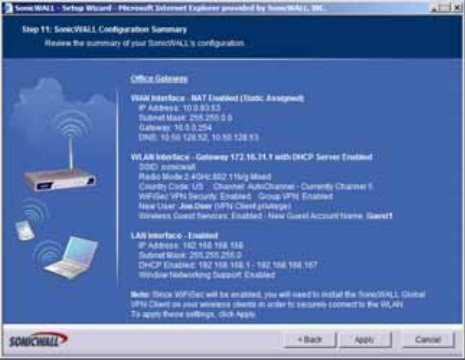
SonicWALL TZ 150 Wireless Getting Started Guide Page 19
12. SonicWALL Configuration Summary - Displays your network
configuration information.
Setup Wizard Complete - your SonicWALL TZ 150 Wireless is now
successfully configured for LAN, Wireless, and Internet access. Click
Restart to complete the configuration process.
13. Test your connection: After the SonicWALL TZ 150 Wireless
reboots, open a Web browser, and go to
<http://www.sonicwall.com>
If you can view the SonicWALL home page, you have configured
everything correctly.
If you cannot view the SonicWALL home page try a second URL.
If you still cannot view a Web page, return to procedure 4,
“Accessing the Management Interface” on page 7, log in as
“admin” with your administrative password, and click on the
Wizards button in the top right corner of the management
interface to restart the wizard.

Page 20
Registering Your
SonicWALLTZ 150 Wireless
Once you’ve established your Internet connection, it is recommended
you register your SonicWALL security appliance at
mySonicWALL.com. Registering your SonicWALL security appliance
provides the following benefits:
• Try a FREE 30-day trial of SonicWALL's
Gateway Anti-Virus, Anti-Spware and Intrusion Prevention
Service, Content Filtering Service, Enforced-Client Anti-Virus/
Anti-Spyware.
• Activate SonicWALL security services
• Access SonicOS firmware updates
• Get SonicWALL technical support
Alert: The Time Zone and DNS settings on your
SonicWALL TZ 150 Wireless must be set correctly before registering
your security appliance. See Step 5, “Using the SonicWALL Setup
Wizard” on page 9 for instructions on setting the Time Zone and DNS
settings.
Before You Register
You need a mySonicWALL.com account to register the
SonicWALL TZ 150 Wireless. You can create a new
mySonicWALL.com account directly from the SonicWALL
management interface.
Alert: Make sure the DNS and Time settings on your
SonicWALL TZ 150 Wireless are correct when you register the
device. Configure Time settings in the System > Time page.
Configure DNS settings in the Edit Interface window from the
Network > Interfaces page.
Note: mySonicWALL.com registration information is not sold or
shared with any other company.
6
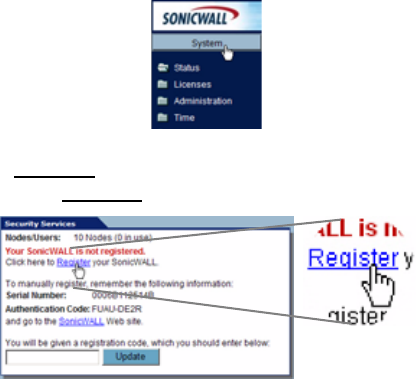
SonicWALL TZ 150 Wireless Getting Started Guide Page 21
Creating a mySonicWALL.com Account
Creating a mySonicWALL.com account is fast, simple, and FREE.
Simply complete an online registration form in the
SonicWALL TZ 150 Wireless management interface.
If you already have a mysonicWALL.com account, go to “Registering
Your SonicWALL TZ 150 Wireless” on page 23 to register your
appliance.
1. If you are not logged into the SonicWALL TZ 150 Wireless
management interface log in with the username admin and the
administrative password you set in the Setup Wizard.
2. If the System > Status page is not displaying in the management
interface, click System in the left-navigation menu, and then click
Status.
3. On the System > Status page, in the Security Services section,
click the Register link in Your SonicWALL is not registered.
Click here to Register your SonicWALL.
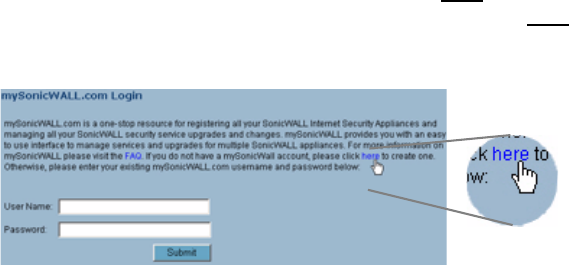
Page 22
4. In the mySonicWALL.com Login page, click the here link in “If
you do not have a mySonicWALL account, please click here
to create one.” The mySonicWALL.com account form is
displayed.
5. In the MySonicWall Account page, enter in your information in
the Account Information, Personal Information and
Preferences fields. All fields marked with an asterisk (*) are
required fields.
Note: Remember your username and password to access your
mySonicWALL.com account.
6. Click Submit after completing the MySonicWALL Account form.
7. When the mySonicWALL.com server has finished processing
your account, you will see a page saying that your account has
been created. Click Continue.
Congratulations. Your mySonicWALL.com account is activated.
Now you need to log into mySonicWALL.com to register your
SonicWALL TZ 150 Wireless.
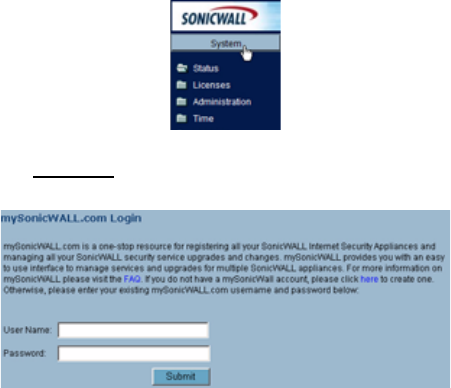
SonicWALL TZ 150 Wireless Getting Started Guide Page 23
Registering Your SonicWALLTZ 150 Wireless
1. If you are not logged into the SonicWALL TZ 150 Wireless
management interface, log in with the username admin and the
administrative password you set in the Setup Wizard.
2. If the System > Status page is not displaying in the management
interface, click System in the left-navigation menu, and then click
Status.
3. On the System > Status page, in the Security Services section,
click the Register link. The mySonicWALL.com Login page is
displayed.
4. Enter your mySonicWALL.com account username and password
in the User Name and Password fields, then click Submit.
5. The next several pages inform you about SonicWALL’s Security
Services. Click Continue on each page.
6. At the top of the Product Survey page, enter a “friendly name”
for your SonicWALL security appliance in the Friendly Name
field. The friendly name allows you to easily identify your
SonicWALL security appliance in your mySonicWALL.com
account.
7. Please complete the Product Survey. SonicWALL uses this
information to further tailor services to fit your needs.
Page 24
Note: SonicWALL Product Survey information is not sold or shared
with any other company.
8. Click Submit.
9. When the mySonicWALL.com server has finished processing
your registration, you will see a page informing you that your
SonicWALL TZ 150 Wireless appliance is registered. Click
Continue, and the System > Licenses page is displayed
showing the available security services. You can activate the
services from this page now or at any time in the future.
Congratulations
Your SonicWALL TZ 150 Wireless is now fully operational.
You can continue with this Getting Started Guide to:
• Activate SonicWALL Security Services.
• Set up computers on your network
• Mount your SonicWALL TZ 150 Wireless on a wall or to any
vertical surface

SonicWALL TZ 150 Wireless Getting Started Guide Page 25
Activating SonicWALL Security
Services
When you register your SonicWALL TZ 150 Wireless, you are eligible
for a Free Trial of the SonicWALL Security Services:
•Gateway Anti-Virus/Anti-Spyware/Intrusion Prevention
Service - Provides real-time protection for all hosts behind your
SonicWALL from viruses, spyware, worms and application-layer
attacks using deep packet inspection to detect and prevent
malicious content before it can reach hosts on your network
•Enforced Client Anti-Virus/Anti-Spyware - protects hosts on
your network from viruses by enforcing the use of client-based
Anti Virus software
•Premium Content Filtering Service - Enhances productivity by
limiting access to objectionable Web content
At the end of your free trial period, the services will automatically
expire unless you purchase a subscription from your reseller or at
<https://www.mySonicWALL.com>.
Activate the SonicWALL Security Services
If your SonicWALL management interface is displaying the
Manage Services Online table on the System > Licenses page,
skip to Step 5.
1. Log in to your SonicWALL management interface.
2. In the left-navigation menu, click System and then Licenses.
3. Near the bottom of the System > Licenses page, under Manage
Security Services Online, click the link: For Free Trials, Click
Here.
4. Log in with your mySonicWALL.com account name and
password, if prompted.
5. In the Manage Services Online table, click Try in the Free Trial
column for Gateway Anti-Virus.
7
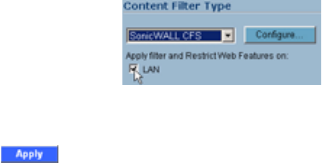
Page 26
6. In the SonicWALL Gateway Anti-Virus page, click Continue.
Your Gateway Anti-Virus, Anti-Spyware, and Intrusion Prevention
Service free trial is now activated.
7. In the Manage Services Online table, click Try in the Free Trial
column for Enforced-Client Anti-Virus/Anti-Spyware and for
CFS Premium Service to activate the
Complete Anti-Virus and Content Filtering Service (CFS) free
trials.
Your SonicWALL Security Service free trials are now activated. You
must now enable each service on your SonicWALL security
appliance. Use the following instructions to configure each service
with its default values. For complete configuration instructions, see
the administrative guides available on your SonicWALL Resource CD
and on the Web at:
<http://www.sonicwall.com/us/support.html>.
Enabling Premium Content Filtering Service
1. Select the Security Services > Content Filter page in the
SonicWALL
management interface.
2. Select the LAN checkbox to apply the filter to all computers on
your LAN interface.
3. Click Configure, select the categories to block in the URL List
tab, and click OK.
4. Click in the top-right corner of the page.
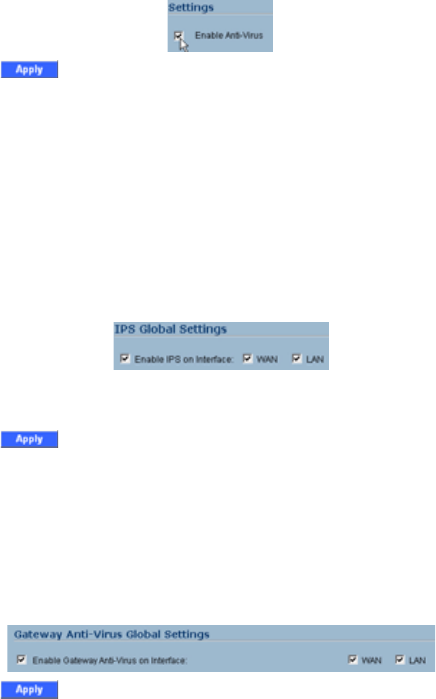
SonicWALL TZ 150 Wireless Getting Started Guide Page 27
Enabling Enforced Anti-Virus/Anti-Spyware Service
1. Select the Security Services > Enforced Client Anti-Virus/
Anti-Spyware page in the SonicWALL management interface.
2. Select the Enable Anti-Virus checkbox.
3. Click in the top-right corner of the page.
Users on your network will be prompted to download the SonicWALL
Anti-Virus client.
Enabling Intrusion Prevention Service
1. Select the Security Services > Intrusion Prevention page in
the SonicWALL management interface.
2. In the IPS Global Settings section, click the Enable IPS on
Interface checkbox,
and check the WAN and LAN interface check boxes.
3. In the Signature Groups table, select Prevent All for High
Priority attacks.
4. Click in the top-right corner of the page.
Enabling Gateway Anti-Virus Service
1. Select the Security Services > Gateway Anti-Virus page in the
SonicWALL management interface.
2. In the Gateway Anti-Virus Global Settings section, click the
Enable Gateway Anti-Virus on Interface checkbox, and check
the WAN and LAN interface boxes.
3. Click in the top-right corner of the page.

Page 28
Enabling Anti-Spyware Service
1. Select the Security Services > Anti-Spyware page in the
SonicWALL management interface.
2. In the Gateway Anti-Spyware Global Settings section, click the
Enable Anti-Spyware checkbox.
3. Select which interfaces you want to apply Anti-Spyware service
on, You can select any combination of WAN, LAN, and OPT.
4. For best protection from spyware, select the Prevent All
checkbox for High, Medium, and Low danger levels. This will
block all spyware that can be detected.
5. Click in the top-right corner of the page.
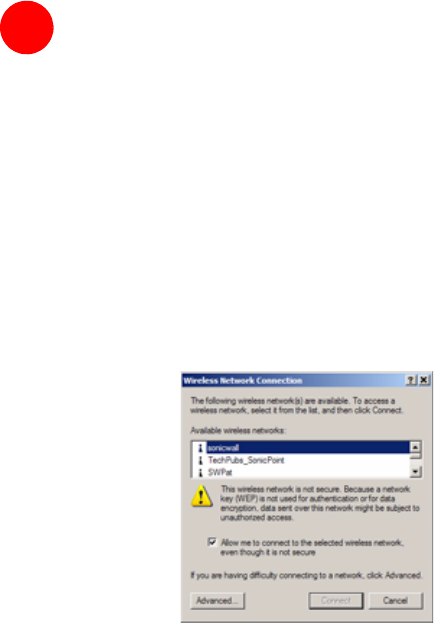
SonicWALL TZ 150 Wireless Getting Started Guide Page 29
Connecting Wireless Clients to the
SonicWALLTZ 150 Wireless
For wireless clients to connect to your WLAN zone, they need:
• A wireless network card installed and configured for the
SonicWALL TZ 150 Wireless’ SSID
• SonicWALL GVC installed and configured for a secure
wireless connection
Connecting to the Wireless Network
You connect to the wireless network according to the requirements of
your client operating system. Your wireless client may automatically
detect and display the SonicWALL TZ 150 Wireless’ SSID in a list of
available wireless networks or you may need to manually configure
your wireless card with the SonicWALL TZ 150 Wireless’ SSID.
8
Page 30
Establishing Secure Wireless Connections
For a wireless client to securely connect to the
SonicWALL TZ 150 Wireless using WiFiSec, the SonicWALL Global
VPN Client (GVC) must be installed and configured, and WiFiSec
must be enabled. Installing and configuring SonicWALL GVC involves
the following procedures:
• “Installing the SonicWALL GVC Using the Setup Wizard” on
page 30
• “Creating an Office Gateway Connection Profile Using the New
Connection Wizard” on page 31
• “Establishing a WiFiSec VPN Connection Using the WLAN
GroupVPN Policy” on page 32
Installing the SonicWALL GVC Using the Setup Wizard
If necessary, install the SonicWALL GVC. It is available either as the
standalone SonicWALL GVC. Follow the instructions in the Setup
Wizard to install SonicWALL GVC.
Note: SonicWALL GVC is free to use for WiFiSec secured wireless
connections. For remote VPN access through a WAN port, you must
have a GVC Client License. For complete product documentation on
SonicWALL GVC, see your Resource CD or visit the SonicWALL
Web site at
<http://www.sonicwall.com/us/support.html>.
Tip: You can download the latest GVC installer at SonicWALL’s
product Web site at
<http://help.mysonicwall.com/applications/vpnclient>.
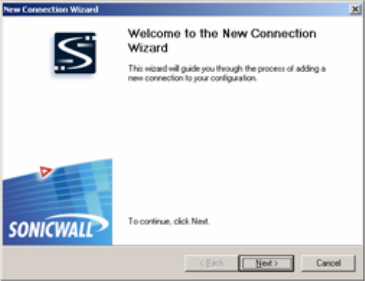
SonicWALL TZ 150 Wireless Getting Started Guide Page 31
Creating an Office Gateway Connection Profile Using the
New Connection Wizard
1. In your Windows Start Menu, Choose Start > Programs >
SonicWALL Global VPN Client. The first time you open
SonicWALL GVC, the New Connection Wizard automatically
launches.
If the New Connection Wizard does not display, click the New
Connection Wizard icon on the far left side of the toolbar to
launch it. Click Next.
2. In the Choose Scenario page, select Office Gateway. Click
Next.
3. In the Completing the New Connection Wizard page select
any of the following options:
•Select Create a desktop shortcut to this connection, if you
want to create a shortcut icon on your desktop for this VPN
connection.
•Select Enable this connection when the program is
launched, if you want to automatically establish this VPN
connection when you launch the SonicWALL Global VPN
Client.
4. Click Finish. The new VPN connection policy appears in the
SonicWALL Global VPN Client window.
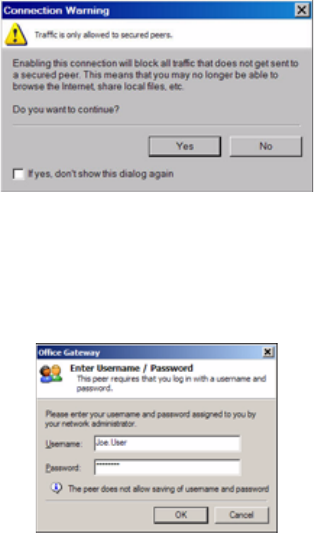
Page 32
Establishing a WiFiSec VPN Connection Using the WLAN
GroupVPN Policy
1. In the SonicWALL Global VPN Client window, double-click the
Office Gateway profile. The Connection Warning dialog box is
displayed, which informs you that all traffic that is not going to the
secured VPN gateway will be blocked.
2. Click Yes to continue.
3. In the Enter Username/Password dialog box, enter the
authentication credentials for the user configured on the
SonicWALL security appliance’s local user database for access
to the WLAN GroupVPN.
4. Click OK. You now have secure wireless access to all the
networks, subnets, and addresses you assigned the user access.
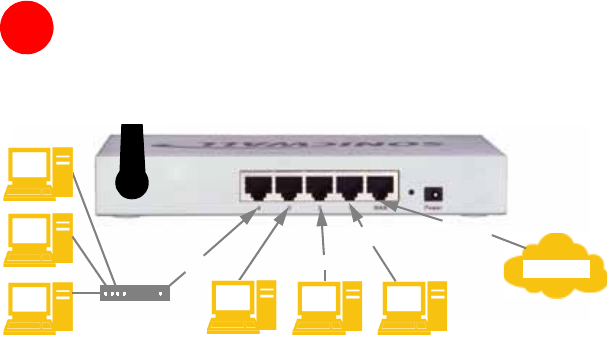
SonicWALL TZ 150 Wireless Getting Started Guide Page 33
Connecting Computers to Your
SonicWALLTZ 150 Wireless
You can attach up to ten computers to your
SonicWALL TZ 150 Wireless.
9
Internet
WAN
LAN 3
LAN 2LAN 4
LAN 1
Hub

Page 34
Configuring DHCP IP Addressing
Complete the following section based on your operating system in order to
configure your management computer to obtain an IP address automatically
(using DHCP addressing):
Note: If you are not using DHCP, refer to the SonicOS Standard
Administrator’s Guide available on the SonicWALL Resource CD and
on the SonicWALL’s Documentation Web Site at:
<http://www.sonicwall.com/us/support.html>.
Windows Vista
1. From the Start menu, right-click Network and select Properties.
2. In the Tasks menu, click Manage network connections, the
Network Connections windows displays.
3. Right-click on your Local Area Connection and select
Properties.
4. In the list, double-click Internet Protocol Version 4 (TCP/IP).
5. Select Obtain an IP address automatically and Obtain a DNS
address automatically.
6. Click OK, and then click OK again for the settings to take effect.
Windows XP
1. From the Start menu, highlight Connect To and then select
Show All Connections.
2. Right-click on your Local Area Connection and select
Properties.
3. In the list, double-click Internet Protocol (TCP/IP).
4. Select Obtain an IP address automatically and Obtain a DNS
address automatically.
5. Click OK, and then click OK again for the settings to take effect.
Windows 2000
1. From your Windows Start menu, select Settings.
2. Open Network and Dial-up Connections.
3. Click Properties.
SonicWALL TZ 150 Wireless Getting Started Guide Page 35
4. Highlight Internet Protocol (TCP/IP) and click Properties.
5. Select Obtain an IP address automatically and Obtain a DNS
address automatically.
6. Click OK for the settings to take effect.

Page 36
Wall Mounting the
SonicWALLTZ 150 Wireless
You can mount your SonicWALL TZ 150 Wireless on a wall or any
vertical surface. Use the template on the next page as a guide for
placing the mounting screws.
1. Using the template on the next page, attach two screws to the
surface where you want to mount the security appliance.
The mounting screws should have a head between 3/16” and
1/4” in diameter.
The mounting screws should stick approximately 1/8” out from
the surface.
2. Slide the slots in the back of the SonicWALL TZ 150 Wireless
over the heads of the mounting screws and then slide the security
appliance down to secure it in place.
10

SonicWALL TZ 150 Wireless Getting Started Guide Page 37
SonicWALL TZ 150 Wireless Mounting Template
Align front
corner here
Attach mounting screw here
Considerations for Mounting the SonicWALL TZ 150 Wireless
• Mount in a location away from direct sunlight and sources of heat.
A maximum ambient temperature of 104º F (40º C) is
recommended.
• Route cables away from power lines, fluorescent lighting fixtures,
and sources of noise such as radios, transmitters, and broadband
amplifiers
• Ensure that no water or excessive moisture can enter the unit.
• Allow unrestricted airflow around the unit and through the vents
on the side of the unit. A minimum of 1 inch (25.44mm) clearance
is recommended.
Attach mounting screw here

Page 38
SonicWALLTZ 150 Wireless Security
Appliance Regulatory Statement and Safety
Instructions
Note: Detailed regulatory information can be found in the electronic
file, “SonicWALL_TZ_150_Wireless_Regulatory_Statement.pdf,”
located on the SonicWALL Resource CD provided with the unit or on
the SonicWALL Web site: <http://www.sonicwall.com>.
Cable Connections
All Ethernet and RS232 (Console) cables are designed for intra-
building connection to other equipment. Do not connect these ports
directly to communication wiring or other wiring that exits the building
where the SonicWALL is located.
Power Supply Information
If you need to order a power supply for your
SonicWALL TZ 150 Wireless, please contact SonicWALL Technical
Support at 408-752-7819 for a replacement. This product should only
be used with a UL listed power supply marked “Class 2” or “LPS”,
with an output rated 12 VDC, minimum 1.66 A.
Considerations for Mounting
See the “SonicWALL TZ 150 Wireless Mounting Template” on
page 37.
North American Authorized Channels
SonicWALL declares that the APL15-054 (FCC ID: QWU-054) (IC:
4408A-054) when sold in US or Canada is limited to CH1~CH11 by
specified firmware controlled in the USA.
Regulatory Model/Type Product Name
APL15-054 TZ 150 Wireless
SonicWALL TZ 150 Wireless Getting Started Guide Page 39
Glossary of Networking Terms
•Default Gateway - A device on an internetwork that forwards
packets to another network.
•DHCP - Dynamic Host Configuration Protocol allocates IP
addresses to computers on the network automatically without
assigning a computer a static (fixed) IP address.
•DNS - A Domain Name System is a hierarchical naming system
that resolves a domain name with its associated IP address. A
DNS server looks up the name of a computer and finds the
corresponding IP address. This allows users to access hosts
using friendly text-based names instead of IP addresses. These
names are called fully qualified domain names (FQDN).
•IP Address - An Internet Protocol Address is a thirty-two bit
number that identifies a computer or other resource on the
Internet or on any TCP/IP network. The number is usually
expressed as four numbers from 0 to 255 separated by periods,
for example, 172.16.31.254.
•LAN - A Local Area Network is typically a group of computers
located at a single location, and is commonly based on the
Ethernet architecture.
•NAT - Network Address Translation is an internet standard that
allows your local network to use private IP addresses, which are
not recognized on the Internet. The IP address used for the router
is the only routable IP address. The computers behind the NAT
can access the Internet through the router, but Internet users
cannot access the computers behind the router.
•Packet - A unit of information transmitted over the internet or
within any TCP/IP network. Packets have a header, which
contains information about the source, destination, and protocol
to be used for the data, and a body, which contains the data being
transmitted.
•PPPoE - The Point to Point Protocol over Ethernet supports the
transmission of network packets over an analog phone line.
•Private IP Address - An IP address for a resource in your
network that is not known or published outside the zone (for
example LAN) where it is located.
Page 40
•Public IP Address - An IP address for a resource in your
network that is published outside your network to the WAN.
•Router - A device that routes data between networks through IP
address information in the header of the IP packet. A router
forwards packets to other routers until the packets reach their
destination. The Internet is the largest example of a routed
network.
•Subnet - A portion of a network. Each subnet within a network
shares a common network address and is uniquely identified by a
subnetwork number.
•Subnet Mask - A 32-bit number used to separate the network
and host sections of an IP address. A subnet mask subdivides an
IP network into smaller pieces. An example of a subnet mask
might be 255.255.255.248 for subnet with only eight IP
addresses.
•TCP/IP - Transmission Control Protocol/Internet Protocol is the
basic communication protocol of the Internet. It supports sending
information in packets, and identifies each device with a unique
numeric IP address.
•VPN - A Virtual Private Network is a virtual network that encrypts
data and sends it privately over the Internet to protect sensitive
information.
•WAN - A Wide Area Network is a geographically distributed
network composed of multiple networks joined into a single large
network. The Internet is a global WAN.
SonicWALL TZ 150 Wireless Getting Started Guide Page 41
Copyright Notice
© 2007 SonicWALL, Inc.
All rights reserved.
Under the copyright laws, this manual or the software described within,
cannot be copied, in whole or part, without the written consent of the
manufacturer, except in the normal use of the software to make a backup
copy. The same proprietary and copyright notices must be affixed to any
permitted copies as were affixed to the original. This exception does not allow
copies to be made for others, whether or not sold, but all of the material
purchased (with all backup copies) can be sold, given, or loaned to another
person. Under the law, copying includes translating into another language or
format.
Specifications and descriptions subject to change without notice.
Trademarks
SonicWALL is a registered trademark of SonicWALL, Inc.
Microsoft Windows 98, Windows Vista, Windows 2000, Windows XP,
Windows Server 2003, Internet Explorer, and Active Directory are trademarks
or registered trademarks of Microsoft Corporation.
Netscape is a registered trademark of Netscape Communications
Corporation in the U.S. and other countries. Netscape Navigator and
Netscape Communicator are also trademarks of Netscape Communications
Corporation and may be registered outside the U.S.
Adobe, Acrobat, and Acrobat Reader are either registered trademarks or
trademarks of Adobe Systems Incorporated in the U.S. and/or other
countries.
Firefox is a trademark of the Mozilla Foundation.
Other product and company names mentioned herein may be trademarks
and/or registered trademarks of their respective companies and are the sole
property of their respective manufacturers.
Page 42
Notes
FCC Statement
This equipment has been tested and found to comply with the limits for a class
digital device, pursuant to Part 15 of the FCC Rules. These limits are designed to
provide reasonable protection against harmful interference in a residential
installation.
This equipment generates, uses and can radiate radio frequency energy and, if not
installed and used in accordance with the instructions, amy cause harmful
interference to radio communications. However, there is no guarantee that
interference will not occur in a particular installation. If this equipment does not
cause harmful interference to radio or television reception, which can be
determined by turning the equipment off and on, the user is encouraged to try to
correct the interference by one of the following measures:
Reorient or relocate the receiving antenna.
Increase the separation between the equipment and receiver.
Connect the equipment into an outlet on a circuit different from that to which
the receiver is connected.
Consult the dealer or an experienced radio/ TV technician for help.
To assure continued compliance, any changed or modifications not expressly
approved by the party responsible for compliance could void the user's authority to
operate this equipment.
FCC Radiation Exposure Statement
This equipment complies with FCC RF radiation exposure limits set forth set forth
an uncontrolled environment. This equipment should be installed and operated with
a minimum distance 20 cm between the radiator and your body.
This device complies with Part 15 of the FCC Rules. Operation is subject to the
following two conditions:
1) This device may not cause harmful interference, and
2) This device must accept any interference received, including interference that
may cause undesired operation.
This transmitter must not be co-located or operating in conjunction with any other
antenna or transmitter.
The antennas used for this transmitter must be installed to provide a separation
distance of at least 20 cm from all persons and must not be co-located or operating
in conjunction with any other antenna or transmitter.
This equipment marketed in USA is restricted by firmware to only operate on 2.4G
channel 1-11.
SonicWALL TZ 150 Wireless Getting Started Guide Page 43
Notes
Canada Statement
Operation is subject to the following two conditions:
1) This device may not cause interference and
2) This device must accept any interference, including interference that may
cause undesired operation of the device.

Europe – EU Declaration of Conformity
This device complies with the essential requirements of the R&TTE Directive 1999/5/EC. The following
test methods have been applied in order to prove presumption of conformity with the essential requirements
of the R&TTE Directive 1999/5/EC:
- EN 60950-1: 2001
Safety of Information Technology Equipment
- EN 50392: 2004
Generic standard to demonstrate the compliance of electronic and electrical apparatus with the basic
restrictions related to human exposure to electromagnetic fields (0 Hz - 300 GHz)
- EN 300 328 V1.7.1 (2006-10)
Electromagnetic compatibility and Radio spectrum Matters (ERM); Wideband transmission systems;
Data transmission equipment operating in the 2,4 GHz ISM band and using wide band modulation
techniques; Harmonized EN covering essential requirements under article 3.2 of the R&TTE Directive
- EN 301 489-17 V1.2.1 (2002-08) and EN 301 489-1 V1.5.1 (2004-11)
Electromagnetic compatibility and Radio spectrum Matters (ERM); ElectroMagnetic Compatibility
(EMC) standard for radio equipment and services; Part 17: Specific conditions for 2,4 GHz wideband
transmission systems and 5 GHz high performance RLAN equipment
This device is a 2.4 GHz wideband transmission system (transceiver), intended for use in all EU member states and
EFTA countries, except in France and Italy where restrictive use applies.
In Italy the end-user should apply for a license at the national spectrum authorities in order to obtain
authorization to use the device for setting up outdoor radio links and/or for supplying public access to
telecommunications and/or network services.
This device may not be used for setting up outdoor radio links in France and in some areas the RF output
power may be limited to 10 mW EIRP in the frequency range of 2454 – 2483.5 MHz. For detailed
information the end-user should contact the national spectrum authority in France.

Česky
[Czech] Netgear Inc. tímto prohlašuje, že tento Prosafe Wireless ADSL Modem VPN Firewall Router je
ve shodě se základními požadavky a dalšími příslušnými ustanoveními směrnice 1999/5/ES.
Dansk
[Danish]
Undertegnede Netgear Inc. erklærer herved, at følgende udstyr Prosafe Wireless ADSL Modem
VPN Firewakk Router overholder de væsentlige krav og øvrige relevante krav i direktiv
1999/5/EF.
Deutsch
[German]
Hiermit erklärt Netgear Inc., dass sich das Gerät Prosafe Wireless ADSL Modem VPN Firewall
Router in Übereinstimmung mit den grundlegenden Anforderungen und den übrigen
einschlägigen Bestimmungen der Richtlinie 1999/5/EG befindet.
Eesti
[Estonian]
Käesolevaga kinnitabNetgear Inc. seadme Prosafe Wireless ADSL Modem VPN Firewall
Router vastavust direktiivi 1999/5/EÜ põhinõuetele ja nimetatud direktiivist tulenevatele teistele
asjakohastele sätetele.
English Hereby, Netgear Inc., declares that this Prosafe Wireless ADSL Modem VPN Firewall Router is
in compliance with the essential requirements and other relevant provisions of Directive
1999/5/EC.
Español
[Spanish]
Por medio de la presente Netgear Inc. declara que el Prosafe Wireless ADSL Modem VPN
Firewall Router cumple con los requisitos esenciales y cualesquiera otras disposiciones
aplicables o exigibles de la Directiva 1999/5/CE.
Ελληνική
[Greek]
ΜΕ ΤΗΝ ΠΑΡΟΥΣΑ Netgear Inc. ∆ΗΛΩΝΕΙ ΟΤΙ Prosafe Wireless ADSL Modem VPN Firewall
Router ΣΥΜΜΟΡΦΩΝΕΤΑΙ ΠΡΟΣ ΤΙΣ ΟΥΣΙΩ∆ΕΙΣ ΑΠΑΙΤΗΣΕΙΣ ΚΑΙ ΤΙΣ ΛΟΙΠΕΣ ΣΧΕΤΙΚΕΣ
∆ΙΑΤΑΞΕΙΣ ΤΗΣ Ο∆ΗΓΙΑΣ 1999/5/ΕΚ.
Français
[French]
Par la présente Netgear Inc. déclare que l'appareil Prosafe Wireless ADSL Modem VPN
Firewall Router est conforme aux exigences essentielles et aux autres dispositions pertinentes
de la directive 1999/5/CE.
Italiano
[Italian]
Con la presente Netgear Inc dichiara che questo Prosafe Wireless ADSL Modem VPN Firewall
Router è conforme ai requisiti essenziali ed alle altre disposizioni pertinenti stabilite dalla
direttiva 1999/5/CE.
Latviski
[Latvian]
Ar šo Netgear Inc. deklarē, ka Prosafe Wireless ADSL Modem VPN Firewall Router atbilst
Direktīvas 1999/5/EK būtiskajām prasībām un citiem ar to saistītajiem noteikumiem.
Lietuvių
[Lithuanian]
Šiuo Netgear Inc deklaruoja, kad šis Prosafe Wireless ADSL Modem VPN Firewall Router
atitinka esminius reikalavimus ir kitas 1999/5/EB Direktyvos nuostatas.
Nederlands
[Dutch]
Hierbij verklaart Netgear Inc. dat het toestel Prosafe Wireless ADSL Modem VPN Firewall
Router in overeenstemming is met de essentiële eisen en de andere relevante bepalingen van
richtlijn 1999/5/EG.
Malti
[Maltese]
Hawnhekk, Netgear Inc., jiddikjara li dan Prosafe Wireless ADSL Modem VPN Firewall Router]
jikkonforma mal-ħtiġijiet essenzjali u ma provvedimenti oħrajn relevanti li hemm fid-Dirrettiva
1999/5/EC.
Magyar
[Hungarian]
Alulírott, Netgear Inc. nyilatkozom, hogy a Prosafe Wireless ADSL Modem VPN Firewall
Router megfelel a vonatkozó alapvetõ követelményeknek és az 1999/5/EC irányelv egyéb
elõírásainak.

Polski
[Polish]
Niniejszym Netgear Inc. oświadcza, że Prosafe Wireless ADSL Modem VPN Firewall Router
jest zgodny z zasadniczymi wymogami oraz pozostałymi stosownymi postanowieniami
Dyrektywy 1999/5/EC.
Português
[Portuguese] Netgear Inc. declara que este Prosafe Wireless ADSL Modem VPN Firewall Router está
conforme com os requisitos essenciais e outras disposições da Directiva 1999/5/CE.
Slovensko
[Slovenian] Netgear Inc. izjavlja, da je ta Prosafe Wireless ADSL Wireless ModemVPN Firewall Router v
skladu z bistvenimi zahtevami in ostalimi relevantnimi določili direktive 1999/5/ES.
Slovensky
[Slovak] Netgear Inc. týmto vyhlasuje, že Prosafe Wireless ADSL Modem VPN Firewall Router spĺňa
základné požiadavky a všetky príslušné ustanovenia Smernice 1999/5/ES.
Suomi
[Finnish] Netgear Inc. vakuuttaa täten että Prosafe Wireless ADSL Modem VPN Firewall Router
tyyppinen laite on direktiivin 1999/5/EY oleellisten vaatimusten ja sitä koskevien direktiivin
muiden ehtojen mukainen.
Svenska
[Swedish]
Härmed intygar Netgear Inc.] att denna Prosafe Wireless ADSL Modem VPN Firewall Router
står I överensstämmelse med de väsentliga egenskapskrav och övriga relevanta bestämmelser
som framgår av direktiv 1999/5/EG.